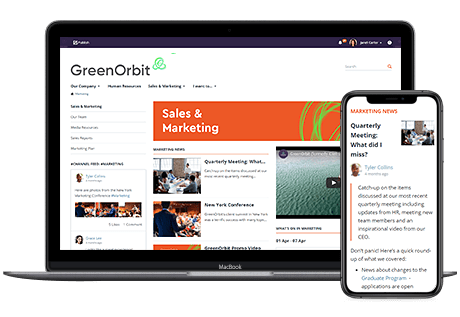
It's official. The conversation around Digital Workplace has gone mainstream.
No longer the secret realm of enterprise IT departments and power-house technology vendors - 'digital workplace' as a Utopian ideal and practical reality is resounding through the halls of government, retail, manufacturing, hospitality, education and healthcare.
Digital transformation is not new - and organizations across all kinds of verticals have been struggling for a decade to get it right. What is new - is that 'every day people' have joined the conversation.
The general population is becoming increasingly tech-savvy and, quite frankly, the digital natives are getting restless.

Companies know they need to adapt - and adapt quickly if they want to win the war on talent, reduce time to market, and innovate their way into a secure future.
So what's holding them back? Why does an effective and seamless digital workplace seem so slippery and elusive?
The transition to a streamlined digital workplace is especially difficult for large enterprises invested in complex technology stacks and legacy applications.
Gartner predicts that from 2018 to 2020, organizations will have spent three times as much on modernizing their legacy applications as they have on digital transformation. Doesn't seem like money well spent.
Despite being out of step with their increasingly mobile and tech-literate workforce, many organizations continue to upgrade and renew antiquated platforms - pushing out key apps on desktop computers.
Why? Because it's hard to connect siloed systems and untangle old technology - but it's even harder to change entrenched processes and stubborn mind-sets.

Current debate suggests that CIOs can lead the charge by taking a broader view - focusing on the value IT can deliver to the business. Not as technology evangelists, but as champions of productivity, innovation and agile processes.
To do this, they need a clear data-driven picture of what's happening on the ground - what do employees expect and what tools do they need to get work done?
What about shadow IT - the apps that employees bring in through the back door to get work done? It's up to organizations to figure out how to give users what they need in a more secure and compliant way.
The phenomenal rise of mobile is forcing many organizations to soften their anti-cloud stance.
A Cloud Vision Survey, conducted by LogicMonitor, reports that 83% of enterprise workload will be on the cloud by 2020 - with 41% of the workload running on public cloud platforms.
Despite this trend, many organizations remain cloud-shy.
Reliability and data security are often cited as top concerns - and it's easy to understand why. Data breaches and cyber attacks feed the media machine and most CIOs want to avoid making those kinds of headlines.
The reality is that large-scale cloud providers like AWS can provide a more reliable and secure infrastructure than could ever be achieved in-house.
As far as cloud-based intranets are concerned - it's important that organizations understand the security measures that vendors have in place.
The questions to ask include:
Here, Gavin Lewis, the Lead Cloud Architect at GreenOrbit talks about these security measures in more detail.
Moving to the cloud makes organizations more nimble because they can side-step the cost and time required to maintain complex systems. What's more, backups and viruses become someone else's problem.
If worries about data security are keeping you from realizing the potential of a cloud-based digital workplace - download this eBook for a deeper dive:

Workplace technology specialists can get all the elements right - finding out what users need, sourcing the best solutions, taking an agile approach - but if senior leaders can't see the value or are distracted by the cost, then the outlook for success is grim.
According to the 2018 Digital Transformation Index, 35% of companies see the CEO as their main obstacle to digital transformation.
This concept of senior executive buy-in was a common thread running through many of the presentations at the recent Digital Workplace Summit in Melbourne.
Speaking from hard-won experience, Jen Goeldner from Transurban explained the importance of "setting senior leader expectations" at the get go. Without management buy-in and support, the road to a successful digital workplace can be a bumpy one - it may even lead to a dead end.
In a similar vein, Rebecca Jackson from NextDC stressed the importance of getting stakeholders on board early in the process - and avoiding the 'big bang' approach.
Bringing departmental silos together and communicating the value of a seamless digital workplace are keys to success - they can't be overlooked in the rush to implement the latest and greatest technology.
Closely aligned to challenge number 3, is the concept of digital workplace adoption. Because, let's face it - there's nothing worse than throwing a party where nobody comes.

In an ideal world, your employees are chomping at the bit - waiting for the ultimate digital workplace to solve their productivity, collaboration and communication issues.
But the reality rarely measures up for a number of reasons:
A digital workplace is not a set-and-forget proposition - it's a long-term commitment that needs to be monitored, measured and improved.
Metrics and key performance indicators should be part of the overall digital workplace strategy - ensuring that the business understands how users are responding; including which elements are working and which are not. Without this information, it's impossible to calculate or communicate digital workplace ROI.
Usage metrics are a good place to start. Monitoring page visits, devices used, average time spent, bounce rates and locations can give organizations a quantitative view of uptake. However, these measures don't tell the whole story.

To track user satisfaction and get a feel for what people are thinking, organizations need to run regular surveys, conduct qualitative interviews or take an ethnographic approach by observing users as they work.
Gathering data is well and good but acting on it is the challenge. Whose job is it? How does it feed into the digital workplace roadmap? Taking an agile and iterative approach, with frequent stakeholder touchpoints, can help.
After all, the digital workplace is a journey, not a destination.
Do any of these challenges resonate with you? We'd love to hear your digital workplace story in the comments below.

